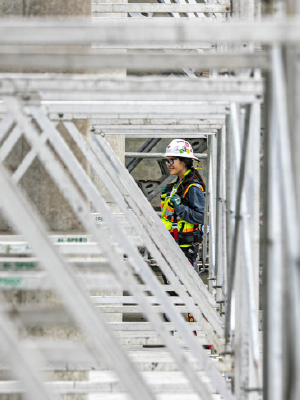Workers experience safety at the intersection of different parts of their identity, including gender. The Women’s Bureau, created in 1920, has been at the forefront of efforts to improve working conditions for women and advocate for their safety over the past century. This Safe + Sound Week, we're exploring three key issues of gender equity in the workplace that relate to occupational safety and health:
Gender-based violence and harassment in the world of work
As recognized in the first U.S. National Plan to end Gender-Based Violence, gender-based violence and harassment is not only a manifestation of discrimination, but also an occupational health and safety issue. Co-workers, supervisors, clients or customers can perpetrate gender-based violence and harassment against workers not only on their job sites, but anywhere workers are paid, in places workers take rest breaks, in work-related training, and through work-related communications. Intimate-partner violence and other forms of gender-based violence can also spill into and impact the workplace, threatening worker safety. For example, if a stalker comes into their victim’s workplace, it can make the employee and others feel unsafe.
When feasible, the Department of Labor’s Occupational Safety and Health Administration (OSHA) enforces the General Duty Clause of the Occupational Safety and Health Act when conducting inspections related to violence at work, including gender-based violence. The General Duty Clause mandates employers to provide “employment and a place of employment which are free from recognized hazards that are causing or are likely to cause death or serious physical harm.”
Additionally, the Women’s Bureau entered into a memorandum of understanding with the International Labor Organization Office for the United States and Canada to uplift the principles and promising practices featured in the ILO Violence and Harassment Convention. One of the key principles is on the importance of identifying hazards and assessing the risks of violence and harassment, with the participation of workers and their representatives, and taking measures to prevent and control them. Prevention is key in ending gender-based violence and harassment in the world of work, particularly by addressing its root causes.
 Personal protective equipment for diverse bodies
Personal protective equipment for diverse bodies
Many employers in male-dominated industries, like the construction trades, do not offer properly fitting personal protective equipment (PPE) and personal protective clothing to all workers, which may compromise women workers’ safety. For example, safety gloves are often too big for women’s hands and can become dangerous if they are loose or get caught in machinery. Similarly, respirators that are too large may not adequately protect women from chemical hazards.
Providing personal protective equipment and clothing for a variety of bodies is a matter of both safety and gender equity. In July 2023, OSHA proposed a rule that would require that equipment fit each affected employee properly to protect them from occupational hazards. And as we’ve learned from the Women’s Bureau’s Women in Apprenticeship and Nontraditional Occupations grant program, providing equipment that fits can help not only keep women safe, but can also help employers retain talented women in pre-apprenticeship, apprenticeship and nontraditional skills training programs.
Maternal mental health
The theme for this year’s Safe and Sound Week is mental health and well-being, and maternal mental health is often overlooked as an area of concern when it comes to occupational health and safety. The Department of Labor is raising awareness that workers have the right to unpaid leave to attend to mental health. Mental health conditions, including conditions like postpartum depression, postpartum anxiety, birth trauma, can be a serious health condition under the FMLA. Additionally, the Equal Employment Opportunity Commission just released proposed Regulations to Implement the Pregnant Workers Fairness Act for public comment, recognizing that mental health conditions related to pregnancy are also qualifying reasons for accommodations.
Learn more about some of the ways the Department of Labor is supporting women’s health and safety:
- Ending Gender-Based Violence at Work and Beyond
- Fostering Access, Rights and Equity (FARE) grant program
- Making PPE the Right Fit for All
- Mental Health and the FMLA
- Mental Health at Work
- Maternal Mental Health Hotline
Katrin Schulz is a policy analyst in the department’s Women’s Bureau. Follow the Women’s Bureau on Twitter at @WB_DOL.

 U.S. Department of Labor Blog
U.S. Department of Labor Blog